国际财务管理第五章
- 格式:ppt
- 大小:2.66 MB
- 文档页数:2

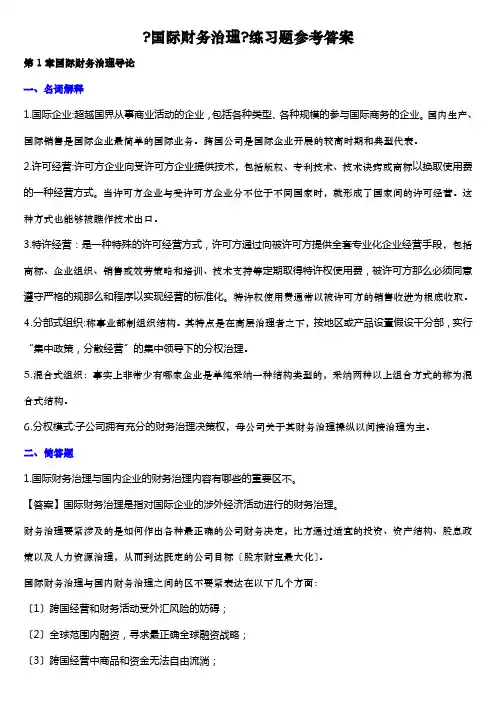
国际财务治理?练习题参考答案第1章国际财务治理导论一、名词解释1.国际企业:超越国界从事商业活动的企业,包括各种类型、各种规模的参与国际商务的企业。
国内生产、国际销售是国际企业最简单的国际业务。
跨国公司是国际企业开展的较高时期和典型代表。
2.许可经营:许可方企业向受许可方企业提供技术,包括版权、专利技术、技术诀窍或商标以换取使用费的一种经营方式。
当许可方企业与受许可方企业分不位于不同国家时,就形成了国家间的许可经营。
这种方式也能够被瞧作技术出口。
3.特许经营:是一种特殊的许可经营方式,许可方通过向被许可方提供全套专业化企业经营手段,包括商标、企业组织、销售或效劳策略和培训、技术支持等定期取得特许权使用费,被许可方那么必须同意遵守严格的规那么和程序以实现经营的标准化。
特许权使用费通常以被许可方的销售收进为根底收取。
4.分部式组织:称事业部制组织结构。
其特点是在高层治理者之下,按地区或产品设置假设干分部,实行“集中政策,分散经营〞的集中领导下的分权治理。
5.混合式组织:事实上非常少有哪家企业是单纯采纳一种结构类型的,采纳两种以上组合方式的称为混合式结构。
6.分权模式:子公司拥有充分的财务治理决策权,母公司关于其财务治理操纵以间接治理为主。
二、简答题1.国际财务治理与国内企业的财务治理内容有哪些的重要区不。
【答案】国际财务治理是指对国际企业的涉外经济活动进行的财务治理。
财务治理要紧涉及的是如何作出各种最正确的公司财务决定,比方通过适宜的投资、资产结构、股息政策以及人力资源治理,从而到达既定的公司目标〔股东财宝最大化〕。
国际财务治理与国内财务治理之间的区不要紧表达在以下几个方面:〔1〕跨国经营和财务活动受外汇风险的妨碍;〔2〕全球范围内融资,寻求最正确全球融资战略;〔3〕跨国经营中商品和资金无法自由流淌;〔4〕对外投资为股东在全球范围内分散风险。
2.试述国际财务治理体系的内容。
【答案】国际财务治理体系的内容要紧包括:〔1〕国际财务治理环境。

CHAPTER 5 THE MARKET FOR FOREIGN EXCHANGESUGGESTED ANSWERS AND SOLUTIONS TO END-OF—CHAPTERQUESTIONS AND PROBLEMSQUESTIONS1。
Give a full definition of the market for foreign exchange。
Answer: Broadly defined, the foreign exchange (FX) market encompasses the conversion of purchasing power from one currency into another,bank deposits of foreign currency, the extension of credit denominated in a foreign currency,foreign trade financing, and trading in foreign currency options and futures contracts。
2。
What is the difference between the retail or client market and the wholesale or interbank market for foreign exchange?Answer:The market for foreign exchange can be viewed as a two—tier market. One tier is the wholesale or interbank market and the other tier is the retail or client market. International banks provide the core of the FX market. They stand willing to buy or sell foreign currency for their own account。
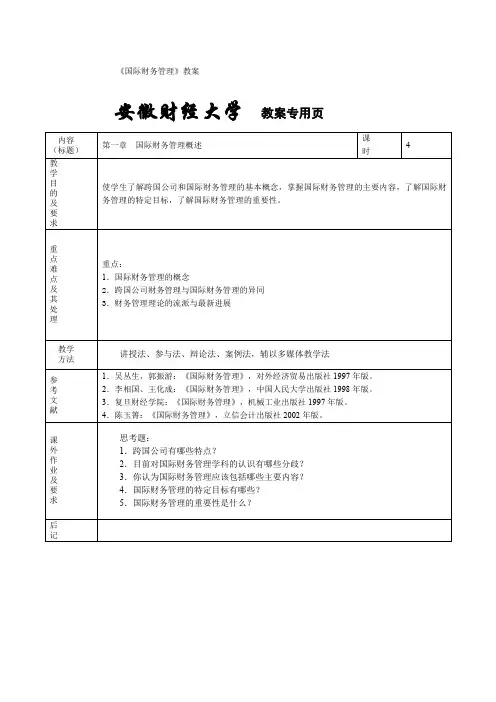
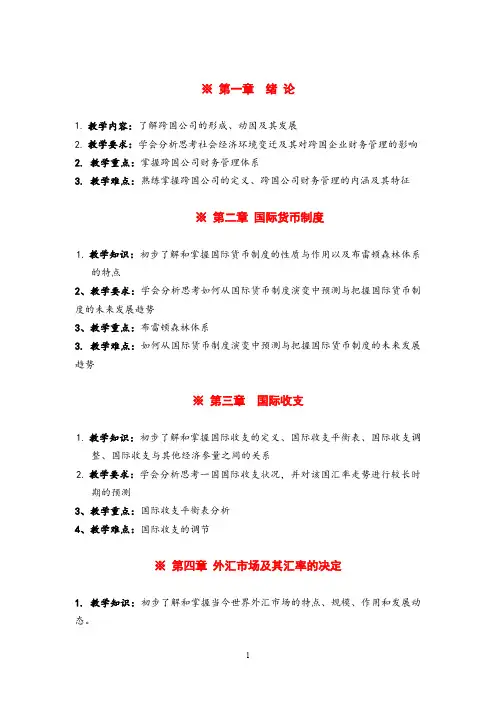
※第一章绪论1.教学内容:了解跨国公司的形成、动因及其发展2.教学要求:学会分析思考社会经济环境变迁及其对跨国企业财务管理的影响2. 教学重点:掌握跨国公司财务管理体系3. 教学难点:熟练掌握跨国公司的定义、跨国公司财务管理的内涵及其特征※第二章国际货币制度1.教学知识:初步了解和掌握国际货币制度的性质与作用以及布雷顿森林体系的特点2、教学要求:学会分析思考如何从国际货币制度演变中预测与把握国际货币制度的未来发展趋势3、教学重点:布雷顿森林体系3. 教学难点:如何从国际货币制度演变中预测与把握国际货币制度的未来发展趋势※第三章国际收支1.教学知识:初步了解和掌握国际收支的定义、国际收支平衡表、国际收支调整、国际收支与其他经济参量之间的关系2.教学要求:学会分析思考一国国际收支状况,并对该国汇率走势进行较长时期的预测3、教学重点:国际收支平衡表分析4、教学难点:国际收支的调节※第四章外汇市场及其汇率的决定1. 教学知识:初步了解和掌握当今世界外汇市场的特点、规模、作用和发展动态。
2. 教学重点:学会即期和远期外汇交易业务及其运作方式3. 教学难点:灵活运用外汇市场基本交易技能为公司解决套期保值达到规避外汇风险的目的※第五章国际银行业务与货币市场1、教学知识:国际金融市场分类及其特点、短期融资工具、欧洲货币市场2、教学重点:欧洲货币市场※第六章国际债券市场学习目标:初步了解和掌握世界债券市场的基本概况、国际债券融资工具的具体操作,区别和比较本国债券、外国债券和欧洲债券之间的异同点,掌握国际债券市场的信用评级以及欧洲债券市场的结构和实务。
教学重点:区别和比较本国债券、外国债券和欧洲债券之间的异同点。
※第八章外汇期货与期权市场1、目标要求:初步了解和掌握外汇期货市场的基本特征;与远期外汇合约的异同;了解并熟悉外汇期权合约的各项技术及特性;学会利用外汇期货与期权市场进行合理避险。
2、习题A、美国某出口商3月10号向加拿大出口一批货物,价值500000加元,以加元结算,3个月后收回货款。

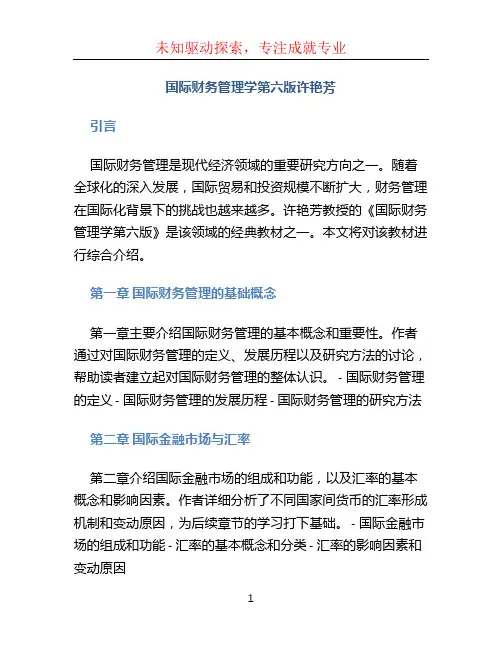
国际财务管理学第六版许艳芳引言国际财务管理是现代经济领域的重要研究方向之一。
随着全球化的深入发展,国际贸易和投资规模不断扩大,财务管理在国际化背景下的挑战也越来越多。
许艳芳教授的《国际财务管理学第六版》是该领域的经典教材之一。
本文将对该教材进行综合介绍。
第一章国际财务管理的基础概念第一章主要介绍国际财务管理的基本概念和重要性。
作者通过对国际财务管理的定义、发展历程以及研究方法的讨论,帮助读者建立起对国际财务管理的整体认识。
- 国际财务管理的定义 - 国际财务管理的发展历程 - 国际财务管理的研究方法第二章国际金融市场与汇率第二章介绍国际金融市场的组成和功能,以及汇率的基本概念和影响因素。
作者详细分析了不同国家间货币的汇率形成机制和变动原因,为后续章节的学习打下基础。
- 国际金融市场的组成和功能 - 汇率的基本概念和分类 - 汇率的影响因素和变动原因第三章跨国公司的财务目标第三章重点讨论跨国公司的财务目标和风险管理。
作者通过对不同财务目标的比较和分析,介绍了传统财务目标与现代财务目标之间的区别和联系,并讨论了跨国公司如何管理汇率和利率风险。
- 传统财务目标与现代财务目标的比较 - 跨国公司的财务目标和风险管理 - 汇率和利率风险管理策略第四章国际金融市场与金融工具第四章重点介绍国际金融市场的各种金融工具和交易方式。
作者通过具体案例分析,帮助读者理解金融市场的运作机制和交易方式,并介绍了国际证券市场、外汇市场和衍生品市场的特点和参与者。
- 国际证券市场和股票交易 - 外汇市场和汇率交易 - 衍生品市场和风险管理工具第五章国际财务报告与分析第五章主要介绍国际财务报告的基本概念和要求,以及财务分析的方法和技巧。
作者通过对国际财务报告准则和标准的解读,帮助读者理解和使用财务报表进行分析和决策。
- 国际财务报告的基本概念和要求 - 财务分析的方法和技巧 - 国际财务报告的解读与分析结论《国际财务管理学第六版》通过系统而全面地介绍了国际财务管理的理论和实践知识。

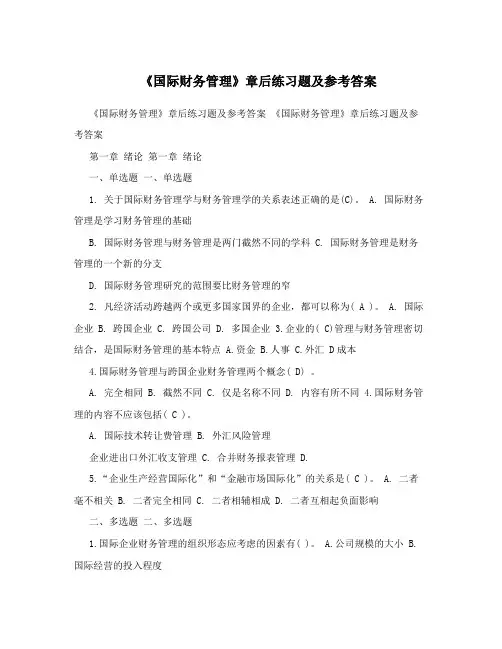
《国际财务管理》章后练习题及参考答案《国际财务管理》章后练习题及参考答案《国际财务管理》章后练习题及参考答案第一章绪论第一章绪论一、单选题一、单选题1. 关于国际财务管理学与财务管理学的关系表述正确的是(C)。
A. 国际财务管理是学习财务管理的基础B. 国际财务管理与财务管理是两门截然不同的学科C. 国际财务管理是财务管理的一个新的分支D. 国际财务管理研究的范围要比财务管理的窄2. 凡经济活动跨越两个或更多国家国界的企业,都可以称为( A )。
A. 国际企业 B. 跨国企业 C. 跨国公司 D. 多国企业3.企业的( C)管理与财务管理密切结合,是国际财务管理的基本特点 A.资金 B.人事 C.外汇 D成本4.国际财务管理与跨国企业财务管理两个概念( D) 。
A. 完全相同B. 截然不同C. 仅是名称不同D. 内容有所不同 4.国际财务管理的内容不应该包括( C )。
A. 国际技术转让费管理B. 外汇风险管理企业进出口外汇收支管理 C. 合并财务报表管理 D.5.“企业生产经营国际化”和“金融市场国际化”的关系是( C )。
A. 二者毫不相关 B. 二者完全相同 C. 二者相辅相成 D. 二者互相起负面影响二、多选题二、多选题1.国际企业财务管理的组织形态应考虑的因素有( )。
A.公司规模的大小 B.国际经营的投入程度C.管理经验的多少D.整个国际经营所采取的组织形式 2.国际财务管理体系的内容包括( )A.外汇风险的管理B.国际税收管理C.国际投筹资管理D.国际营运资金管 3.国际财务管理目标的特点( )。
A.稳定性B.多元性C.层次性D.复杂性4.广义的国际财务管理观包括( )。
A.世界统一财务管理观B.比较财务管理观C.跨国公司财务管理观D.国际企业财务管理观5. 我国企业的国际财务活动日益频繁,具体表现在( )。
A. 企业从内向型向外向型转化 B. 外贸专业公司有了新的发展 C. 在国内开办三资企业 D. 向国外投资办企业 E. 通过各种形式从国外筹集资金三、判断题三、判断题1.国际财务管理是对企业跨国的财务活动进行的管理。

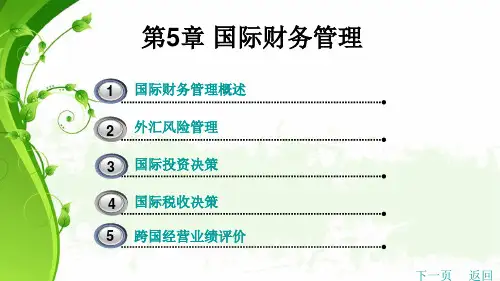
CHAPTER 5 THE MARKET FOR FOREIGN EXCHANGESUGGESTED ANSWERS AND SOLUTIONS TO END-OF-CHAPTERQUESTIONS AND PROBLEMSQUESTIONS1. Give a full definition of the market for foreign exchange.Answer: Broadly defined, the foreign exchange (FX) market encompasses the conversion of purchasing power from one currency into another, bank deposits of foreign currency, the extension of credit denominated in a foreign currency, foreign trade financing, and trading in foreign currency options and futures contracts.2. What is the difference between the retail or client market and the wholesale or interbank market for foreign exchange?Answer: The market for foreign exchange can be viewed as a two-tier market. One tier is the wholesale or interbank market and the other tier is the retail or client market. International banks provide the core of the FX market. They stand willing to buy or sell foreign currency for their own account. These international banks serve their retail clients, corporations or individuals, in conducting foreign commerce or making international investment in financial assets that requires foreign exchange. Retail transactions account for only about 14 percent of FX trades. The other 86 percent is interbank trades between international banks, or non-bank dealers large enough to transact in the interbank market.3. Who are the market participants in the foreign exchange market?Answer: The market participants that comprise the FX market can be categorized into five groups: international banks, bank customers, non-bank dealers, FX brokers, and central banks. International banks provide the core of the FX market. Approximately 100 to 200 banks worldwide make a market in foreign exchange, i.e., they stand willing to buy or sell foreign currency for their own account. These international banks serve their retail clients, the bank customers, in conducting foreign commerce or making international investment in financial assets that requires foreign exchange. Non-bank dealers are large non-bank financial institutions, such as investment banks, mutual funds, pension funds, and hedge funds, whose size and frequency of trades make it cost- effective to establish their own dealing rooms totrade directly in the interbank market for their foreign exchange needs.Most interbank trades are speculative or arbitrage transactions where market participants attempt to correctly judge the future direction of price movements in one currency versus another or attempt to profit from temporary price discrepancies in currencies between competing dealers.FX brokers match dealer orders to buy and sell currencies for a fee, but do not take a position themselves. Interbank traders use a broker primarily to disseminate as quickly as possible a currency quote to many other dealers.Central banks sometimes intervene in the foreign exchange market in an attempt to influence the price of its currency against that of a major trading partner, or a country that it “fixes” or “pegs” its currency against. Intervention is the process of using foreign currency reserves to buy one’s own currency in order to decrease its supply and thus increase its value in the foreign exchange market, or alternatively, selling one’s own currency for foreign currency in order to increase its supply and lower its price.4. How are foreign exchange transactions between international banks settled?Answer: The interbank market is a network of correspondent banking relationships, with large commercial banks maintaining demand deposit accounts with one another, called correspondent bank accounts. The correspondent bank account network allows for the efficient functioning of the foreign exchange market. As an example of how the network of correspondent bank accounts facilities international foreign exchange transactions, consider a U.S. importer desiring to purchase merchandise invoiced in guilders from a Dutch exporter. The U.S. importer will contact his bank and inquire about the exchange rate. If the U.S. importer accepts the offered exchange rate, the bank will debit the U.S. importer’s account for the purchase of the Dutch guilders. The bank will instruct its correspondent bank in the Netherlands to debit its correspondent bank account the appropriate amount of guilders and to credit the Dutch exporter’s bank account. The importer’s bank will then debit its books to offset the debit of U.S. importer’s account, reflecting the decrease in its correspondent bank account balance.5. What is meant by a currency trading at a discount or at a premium in the forward market?Answer: The forward market involves contracting today for the future purchase or sale of foreign exchange. The forward price may be the same as the spot price, but usually it is higher (at a premium) or lower (at a discount) than the spot price.6. Why does most interbank currency trading worldwide involve the U.S. dollar?Answer: Trading in currencies worldwide is against a common currency that has international appeal. That currency has been the U.S. dollar since the end of World War II. However, the euro and Japanese yen have started to be used much more as international currencies in recent years. More importantly, trading would be exceedingly cumbersome and difficult to manage if each trader made a market against all other currencies.7. Banks find it necessary to accommodate their clients’ needs to buy or sell FX forward, in many instances for hedging purposes. How can the bank eliminate the currency exposure it has created for itself by accommodating a client’s forward transaction?Answer: Swap transactions provide a means for the bank to mitigate the currency exposure in a forward trade. A swap transaction is the simultaneous sale (or purchase) of spot foreign exchange against a forward purchase (or sale) of an approximately equal amount of the foreign currency. To illustrate, suppose a bank customer wants to buy dollars three months forward against British pound sterling. The bank can handle this trade for its customer and simultaneously neutralize the exchange rate risk in the trade by selling (borrowed) British pound sterling spot against dollars. The bank will lend the dollars for three months until they are needed to deliver against the dollars it has sold forward. The British pounds received will be used to liquidate the sterling loan.8. A CD/$ bank trader is currently quoting a small figure bid-ask of 35-40, when the rest of the market is trading at CD1.3436-CD1.3441. What is implied about the trader’s beliefs by his prices?Answer: The trader must think the Canadian dollar is going to appreciate against the U.S. dollar and therefore he is trying to increase his inventory of Canadian dollars by discouraging purchases of U.S. dollars by standing willing to buy $ at only CD1.3435/$1.00 and offering to sell from inventory at the slightly lower than market price of CD1.3440/$1.00.9. What is triangular arbitrage? What is a condition that will give rise to a triangular arbitrage opportunity?Answer: Triangular arbitrage is the process of trading out of the U.S. dollar into a second currency, then trading it for a third currency, which is in turn traded for U.S. dollars. The purpose is to earn an arbitrageprofit via trading from the second to the third currency when the direct exchange between the two is not in alignment with the cross exchange rate.Most, but not all, currency transactions go through the dollar. Certain banks specialize in making a direct market between non-dollar currencies, pricing at a narrower bid-ask spread than the cross-rate spread. Nevertheless, the implied cross-rate bid-ask quotations impose a discipline on the non-dollar market makers. If their direct quotes are not consistent with the cross exchange rates, a triangular arbitrage profit is possible.10. Over the past six years, the exchange rate between Swiss franc and U.S. dollar, SFr/$, has changed from about 1.30 to about 1.60. Would you agree that over this six-year period, the Swiss goods have become cheaper for buyers in the United States? (UPDATE? SF has gone from SF1.67/$ to SF1.04/$ over the last six years.)CFA Guideline Answer:The value of the dollar in Swiss francs has gone up from about 1.30 to about 1.60. Therefore, the dollar has appreciated relative to the Swiss franc, and the dollars needed by Americans to purchase Swiss goods have decreased. Thus, the statement is correct.PROBLEMS1. Using Exhibit 5.4, calculate a cross-rate matrix for the euro, Swiss franc, Japanese yen, and the Britishpound. Use the most current American term quotes to calculate the cross-rates so that the triangular matrix resulting is similar to the portion above the diagonal in Exhibit 5.6.Solution: The cross-rate formula we want to use is:S(j/k) = S($/k)/S($/j).The triangular matrix will contain 4 x (4 + 1)/2 = 10 elements.¥ SF £ $Euro 159.91 1.6317 .7478 1.4744 Japan (100) 1.0204.4676 .9220 Switzerland.4583 .9036 U.K 1.97172. Using Exhibit 5.4, calculate the one-, three-, and six-month forward cross-exchange rates between theCanadian dollar and the Swiss franc using the most current quotations. State the forward cross-rates in“Canadian” terms.Solution: The formulas we want to use are:F N (CD/SF) = F N ($/SF)/F N ($/CD)orF N (CD/SF) = F N (CD/$)/F N (SF/$).We will use the top formula that uses American term forward exchange rates.F 1(CD/SF) = .9052/.9986 = .9065F 3(CD/SF) = .9077/.9988 = .9088F 6(CD/SF) = .9104/.9979 = .91233. A foreign exchange trader with a U.S. bank took a short position of £5,000,000 when the $/£ exchange rate was 1.55. Subsequently, the exchange rate has changed to 1.61. Is this movement in the exchange rate good from the point of view of the position taken by the trader? By how much has the bank’s liability changed because of the change in the exchange rate? UPDATE TO CURRENT EX-RATES?CFA Guideline Answer:The increase in the $/£ exchange rate implies that the pound has appreciated with respect to the dollar. This is unfavorable to the trader since the trader has a short position in pounds.Bank’s liability in dollars initially was 5,000,000 x 1.55 = $7,750,000Bank’s liability in dollars now is 5,000,000 x 1.61 = $8,050,0004. Restate the following one-, three-, and six-month outright forward European term bid-ask quotes in forward points.1.3431-1.3436SpotOne-Month 1.3432-1.3442Three-Month 1.3448-1.3463Six-Month 1.3488-1.3508Solution:One-Month 01-06Three-Month 17-27Six-Month 57-725. Using the spot and outright forward quotes in problem 3, determine the corresponding bid-ask spreads in points.Solution:5SpotOne-Month 10Three-Month 15Six-Month 206. Using Exhibit 5.4, calculate the one-, three-, and six-month forward premium or discount for the Canadian dollar versus the U.S. dollar using American term quotations. For simplicity, assume each month has 30 days. What is the interpretation of your results?Solution: The formula we want to use is:f N,CD = [(F N($/CD) - S($/CD/$)/S($/CD)] x 360/Nf1,CD = [(.9986 - .9984)/.9984] x 360/30 = .0024f3,CD = [(.9988 - .9984)/.9984] x 360/90 = .0048f6,CD = [(.9979 - .9984)/.9984] x 360/180 = -.0060The pattern of forward premiums indicates that the Canadian dollar is trading at a premium versus the U.S. dollar for maturities up to three months into the future and then it trades at a discount.7. Using Exhibit 5.4, calculate the one-, three-, and six-month forward premium or discount for the U.S. dollar versus the British pound using European term quotations. For simplicity, assume each month has 30 days. What is the interpretation of your results?Solution: The formula we want to use is:f N,$ = [(F N (£/$) - S(£/$))/S(£/$)] x 360/Nf1,$ = [(.5076 - .5072)/.5072] x 360/30 = .0095f3,$ = [(.5086 - .5072)/.5072] x 360/90 = .0331f6,$ = [(.5104 - .5072)/.5072] x 360/180 = .0757The pattern of forward premiums indicates that the dollar is trading at a premium versus the British pound. That is, it becomes more expensive to buy a U.S. dollar forward for British pounds (in absolute and percentage terms) the further into the future one contracts.8. A bank is quoting the following exchange rates against the dollar for the Swiss franc and the Australian dollar:SFr/$ = 1.5960--70A$/$ = 1.7225--35An Australian firm asks the bank for an A$/SFr quote. What cross-rate would the bank quote?CFA Guideline Answer:The SFr/A$ quotation is obtained as follows. In obtaining this quotation, we keep in mind that SFr/A$ = SFr/$/A$/$, and that the price (bid or ask) for each transaction is the one that is more advantageous to the bank.The SFr/A$ bid price is the number of SFr the bank is willing to pay to buy one A$. This transaction (buy A$—sell SFr) is equivalent to selling SFr to buy dollars (at the bid rate of 1.5960 and the selling those dollars to buy A$ (at an ask rate of 1.7235). Mathematically, the transaction is as follows:bid SFr/A$ = (bid SFr/$)/(ask A$/$) = 1.5960/1.7235 = 0.9260The SFr/A$ ask price is the number of SFr the bank is asking for one A$. This transaction (sell A$—buy SFr) is equivalent to buying SFr with dollars (at the ask rate of 1.5970 and then simultaneously purchasing these dollars against A$ (at a bid rate of 1.7225). This may be expressed as follows:ask SFr/A$ = (ask SFr/$)/(bid A$/$) = 1.5970/1.7225 = 0.9271The resulting quotation by the bank isSFr/A$ = 0.8752—0.87639. Given the following information, what are the NZD/SGD currency against currency bid-ask quotations?AmericanTermsTerms EuropeanBidAskAskQuotations BidBankNew Zealand dollar .7265 .7272 1.3751 1.3765Singapore dollar .6135 .6140 1.6287 1.6300Solution: Equation 5.12 from the text implies S b(NZD/SGD) = S b($/SGD) x S b(NZD/$) = .6135 x 1.3751 = .8436. The reciprocal, 1/S b(NZD/SGD) =S a(SGD/NZD) = 1.1854. Analogously, it is implied that S a(NZD/SGD) = S a($/SGD) x S a(NZD/$) = .6140 x 1.3765 = .8452. The reciprocal, 1/S a(NZD/SGD) = S b(SGD/NZD) = 1.1832. Thus, the NZD/SGD bid-ask spread is NZD0.8436-NZD0.8452 and the SGD/NZD spread is SGD1.1832-SGD1.1854.10. Doug Bernard specializes in cross-rate arbitrage. He notices the following quotes:Swiss franc/dollar = SFr1.5971?$Australian dollar/U.S. dollar = A$1.8215/$Australian dollar/Swiss franc = A$1.1440/SFrIgnoring transaction costs, does Doug Bernard have an arbitrage opportunity based on these quotes? If there is an arbitrage opportunity, what steps would he take to make an arbitrage profit, and how would he profit if he has $1,000,000 available for this purpose.CFA Guideline Answer:A. The implicit cross-rate between Australian dollars and Swiss franc is A$/SFr = A$/$ x $/SFr = (A$/$)/(SFr/$) = 1.8215/1.5971 = 1.1405. However, the quoted cross-rate is higher at A$1.1.1440/SFr. So, triangular arbitrage is possible.B. In the quoted cross-rate of A$1.1440/SFr, one Swiss franc is worth A$1.1440, whereas the cross-rate based on the direct rates implies that one Swiss franc is worth A$1.1405. Thus, the Swiss franc is overvalued relative to the A$ in the quoted cross-rate, and Doug Bernard’s strategy for triangular arbitrage should be based on selling Swiss francs to buy A$ as per the quoted cross-rate. Accordingly, the steps Doug Bernard would take for an arbitrage profit is as follows:i.Sell dollars to get Swiss francs: Sell $1,000,000 to get $1,000,000 x SFr1.5971/$ =SFr1,597,100.ii.Sell Swiss francs to buy Australian dollars: Sell SFr1,597,100 to buy SFr1,597,100 x A$1.1440/SFr = A$1,827,082.40.iii.Sell Australian dollars for dollars: Sell A$1,827,082.40 for A$1,827,082.40/A$1.8215/$ = $1,003,064.73.Thus, your arbitrage profit is $1,003,064.73 - $1,000,000 = $3,064.73.11. Assume you are a trader with Deutsche Bank. From the quote screen on your computer terminal, you notice that Dresdner Bank is quoting €0.7627/$1.00 and Credit Suisse is offering SF1.1806/$1.00. You learn that UBS is making a direct market between the Swiss franc and the euro, with a current €/SF quote of .6395. Show how you can make a triangular arbitrage profit by trading at these prices. (Ignore bid-ask spreads for this problem.) Assume you have $5,000,000 with which to conduct the arbitrage. What happens if you initially sell dollars for Swiss francs? What €/SF price will eliminate triangulararbitrage?Solution: To make a triangular arbitrage profit the Deutsche Bank trader would sell $5,000,000 to Dresdner Bank at €0.7627/$1.00. This trade would yield €3,813,500= $5,000,000 x .7627. The Deutsche Bank trader would then sell the euros for Swiss francs to Union Bank of Switzerland at a price of €0.6395/SF1.00, yielding SF5,963,253 = €3,813,500/.6395. The Deutsche Bank trader will resell the Swiss francs to Credit Suisse for $5,051,036 = SF5,963,253/1.1806, yielding a triangular arbitrage profit of $51,036.If the Deutsche Bank trader initially sold $5,000,000 for Swiss francs, instead of euros, the trade would yield SF5,903,000 = $5,000,000 x 1.1806. The Swiss francs would in turn be traded for euros to UBS for €3,774,969= SF5,903,000 x .6395. The euros would be resold to Dresdner Bank for $4,949,481 = €3,774,969/.7627, or a loss of $50,519. Thus, it is necessary to conduct the triangular arbitrage in the correct order.The S(€/SF) cross exchange rate should be .7627/1.1806 = .6460. This is an equilibrium rate at which a triangular arbitrage profit will not exist. (The student can determine this for himself.) A profit results from the triangular arbitrage when dollars are first sold for euros because Swiss francs are purchased for euros at too low a rate in comparison to the equilibrium cross-rate, i.e., Swiss francs are purchased for only €0.6395/SF1.00 instead of the no-arbitrage rate of €0.6460/SF1.00. Similarly, when dollars are first sold for Swiss francs, an arbitrage loss results because Swiss francs are sold for euros at too low a rate, resulting in too few euros. That is, each Swiss franc is sold for €0.6395/SF1.00 instead of the higher no-arbitrage rate of €0.6460/SF1.00.12. The current spot exchange rate is $1.95/£ and the three-month forward rate is $1.90/£. Based on your analysis of the exchange rate, you are pretty confident that the spot exchange rate will be $1.92/£ in three months. Assume that you would like to buy or sell £1,000,000.a. What actions do you need to take to speculate in the forward market? What is the expected dollar profit from speculation?b. What would be your speculative profit in dollar terms if the spot exchange rate actually turns out to be $1.86/£.Solution:a. If you believe the spot exchange rate will be $1.92/£ in three months, you should buy £1,000,000 forward for $1.90/£. Your expected profit will be:$20,000 = £1,000,000 x ($1.92 -$1.90).b. If the spot exchange rate actually turns out to be $1.86/£ in three months, your loss from the long position will be:-$40,000 = £1,000,000 x ($1.86 -$1.90).13. Omni Advisors, an international pension fund manager, plans to sell equities denominated in Swiss Francs (CHF) and purchase an equivalent amount of equities denominated in South African Rands (ZAR).Omni will realize net proceeds of 3 million CHF at the end of 30 days and wants to eliminate the risk that the ZAR will appreciate relative to the CHF during this 30-day period. The following exhibit shows current exchange rates between the ZAR, CHF, and the U.S. dollar (USD).Currency Exchange RatesZAR/USD ZAR/USD CHF/USD CHF/USDMaturity Bid Ask Bid AskSpot 6.2681 6.2789 1.5282 1.534330-day 6.2538 6.2641 1.5226 1.528590-day 6.2104 6.2200 1.5058 1.5115a.Describe the currency transaction that Omni should undertake to eliminate currency riskover the 30-day period.b.Calculate the following:• The CHF/ZAR cross-currency rate Omni would use in valuing the Swiss equityportfolio.• The current value of Omni’s Swiss equity portfolio in ZAR.• The annualized forward premium or discount at which the ZAR is trading versus theCHF.CFA Guideline Answer:a.To eliminate the currency risk arising from the possibility that ZAR will appreciateagainst the CHF over the next 30-day period, Omni should sell 30-day forward CHF against 30-day forward ZAR delivery (sell 30-day forward CHF against USD and buy 30-day forward ZAR against USD).b.The calculations are as follows:• Using the currency cross rates of two forward foreign currencies and three currencies(CHF, ZAR, USD), the exchange would be as follows:--30 day forward CHF are sold for USD. Dollars are bought at the forward sellingprice of CHF1.5285 = $1 (done at ask side because going from currency intodollars)--30 day forward ZAR are purchased for USD. Dollars are simultaneously sold topurchase ZAR at the rate of 6.2538 = $1 (done at the bid side because going fromdollars into currency)--For every 1.5285 CHF held, 6.2538 ZAR are received; thus the cross currency rate is1.5285 CHF/6.2538 ZAR = 0.244411398.• At the time of execution of the forward contracts, the value of the 3 million CHFequity portfolio would be 3,000,000 CHF/0.244411398 = 12,274,386.65 ZAR.• To calculate the annualized premium or discount of the ZAR against the CHF requires comparison of the spot selling exchange rate to the forward selling price of CHF forZAR.Spot rate = 1.5343 CHF/6.2681 ZAR = 0.24477912030 day forward ask rate 1.5285 CHF/6.2538 ZAR = 0.244411398The premium/discount formula is:[(forward rate – spot rate) / spot rate] x (360 / # day contract) =[(0.244411398 – 0.24477912) / 0.24477912] x (360 / 30) =-1.8027126 % = -1.80% discount ZAR to CHFMINI CASE: SHREWSBURY HERBAL PRODUCTS, LTD.Shrewsbury Herbal Products, located in central England close to the Welsh border, is an old-line producer of herbal teas, seasonings, and medicines. Its products are marketed all over the United Kingdom and in many parts of continental Europe as well.Shrewsbury Herbal generally invoices in British pound sterling when it sells to foreign customers in order to guard against adverse exchange rate changes. Nevertheless, it has just received an order from a large wholesaler in central France for £320,000 of its products, conditional upon delivery being made in three months’ time and the order invoiced in euros.Shrewsbury’s controller, Elton Peters, is concerned with whether the pound will appreciate versus the euro over the next three months, thus eliminating all or most of the profit when the euro receivable is paid. He thinks this is an unlikely possibility, but he decides to contact the firm’s banker for suggestions about hedging the exchange rate exposure.Mr. Peters learns from the banker that the current spot exchange rate is €/£ is €1.4537, thus the invoice amount should be €465,184. Mr. Peters also learns that the three-month forward rates for the pound and the euro versus the U.S. dollar are $1.8990/£1.00 and $1.3154/€1.00, respectively. The banker offers to set up a forward hedge for selling the euro receivable for pound sterling based on the €/£ forward cross-exchange rate implicit in the forward rates against the dollar.What would you do if you were Mr. Peters?Suggested Solution to Shrewsbury Herbal Products, Ltd.Note to Instructor: This elementary case provides an intuitive look at hedging exchange rate exposure. Students should not have difficulty with it even though hedging will not be formally discussed until Chapter 8. The case is consistent with the discussion that accompanies Exhibit 5.9 of the text. Professor of Finance, Banikanta Mishra, of Xavier Institute of Management – Bhubaneswar, India contributed to this solution.Suppose Shrewsbury sells at a twenty percent markup. Thus the cost to the firm of the £320,000 order is £256,000. Thus, the pound could appreciate to €465,184/£256,000 = €1.8171/1.00 before all profit was eliminated. This seems rather unlikely. Nevertheless, a ten percent appreciation of the pound (€1.4537 x 1.10) to €1.5991/£1.00 would only yield a profit of £34,904 (= €465,184/1.5991 - £256,000). Shrewsbury can hedge the exposure by selling the euros forward for British pounds at F3(€/£) = F3($/£) ÷ F3($/€) = 1.8990 ÷ 1.3154 = 1.4437. At this forward exchange rate, Shrewsbury can “lock-in” a price of £322,217 (= €465,184/1.4437) for the sale. The forward exchange rate indicates that the euro is trading at a premium to the British pound in the forward market. Thus, the forward hedge allows Shrewsbury to lock-in a greater amount (£2,217) than if the euro receivable was converted into pounds at the current spotIf the euro was trading at a forward discount, Shrewsbury would end up locking-in an amount less than £320,000. Whether that would lead to a loss for the company would depend upon the extent of the discount and the amount of profit built into the price of £320,000. Only if the forward exchange rate is even with the spot rate will Shrewsbury receive exactly £320,000.Obviously, Shrewsbury could ensure that it receives exactly £320,000 at the end of three-month accounts receivable period if it could invoice in £. That, however, is not acceptable to the French wholesaler. When invoicing in euros, Shrewsbury could establish the euro invoice amount by use of the forward exchange rate instead of the current spot rate. The invoice amount in that case would be €461,984 = £320,000 x 1.4437. Shrewsbury can now lock-in a receipt of £320,000 if it simultaneously hedges its euro exposure by selling €461,984 at the forward rate of 1.4437. That is, £320,000 =€461,984/1.4437.。
第一章:1.什么是国际财务管理国际财务管理,也叫国际理财,是国际企业从事跨国性生产经营活动所面临新的财务管理问题,是研究企业在国际市场中如何对其资金运营活动及其财务关系所进行的管理,它是财务管理在国际领域中的延伸和发展。
2.促使国际财务管理发展的分析①历史发展到20世纪80年代,由于商品经济的国际化发展、世界经济的一体化趋势、国际金融市场体系的形成和跨国公司的崛起,使诞生国际财务管理的社会环境开始成熟。
②跨越国界的生产经营活动是国际财务管理产生的条件。
国际财务管理的诞生是企业的跨国性生产经营活动所产生的需求,其条件必须是商品经济国际化发展到一定程度,国际市场已经比较成熟的时期。
2.促使国际财务管理产生的社会环境:⑴、商品经济国际化的发展;⑵、世界经济的一体化趋势;⑶、跨国公司的全球性经营战略。
3.国际财务管理的基础理论国际财务管理研究的内容(一)外汇风险及其管理(二)全球性的融资策略和方法①.跨国企业可以进行全球性的股本融资。
②.国际企业可以在国际金融市场上筹集多品种的短期流动资金贷款,但要注意融资成本的测算和风险的规避;③.国际企业可以在国际金融市场上筹集中长期信贷。
④.国际企业有机会在更广泛的金融市场进行债务融资。
⑤.国际企业还可以选择特定方向的融资(三)国际投资决策(四)财源的全球性调配(五)国际营运资本管理(六)国际税务管理(七)国际反倾销的财务对策4.财务管理目标理论:(一)利润最大化(二)净现值最大化(三)资金成本最小化(四)股东财富最大化第二章:1. 直接标价法又称为应付标价法,是以一定单位的外国货币作为标准,折算为本国货币来表示其汇率。
间接标价法又称为应收标价法,是以一定单位的本国货币为标准,折算为一定数额的外国货币来表示其汇率。
2.汇率的分类(1)按外汇交易交割期限为标准,可划分为:即期汇率:也叫现汇汇率,是指买卖外汇双方成交当天或两天以内进行交割的汇率。
远期汇率:是在未来一定时期进行交割,而事先由买卖双方签订合同、达成协议的汇率。
国际财务管理复习资料第一章总论国际企业财务管理的内容,其中区别于国内财务管理的内容是外汇内容管理。
影响国际企业财务管理的因素,其中重点是经济因素,第一,金融市场和金融结构的完善程度关系到该国投资和融资的难易程度;第二,金融政策,如实行的是浮动汇率还是固定汇率,政府是否对外汇实行严格管制,政府是否采取紧缩的货币政策抑制投资、金融市场的深度和广度;第三,该国的市场是否健全;此外,该国的财政税收政策、产业政策、对外贸易政策等,也会对国际企业的财务管理带来重大影响。
三种类型的跨国公司:raw material , new maket, minimize cost。
国际企业财务管理的控制模式分两种,集权模式和分权模式。
集权模式的优点有:集中利用财务专家,降低资金成本,优化公司资源配置,降低公司赋税,增强抗风险能力。
缺点是:不利于调动公司积极性,不利协调当地持股人的关系,可能激化与东道国的矛盾,不利于考核子公司的业绩。
第二章国际金融市场国际金融市场的含义:是在居民与非居民之间或非居民与非居民之间实现如外汇、资金、有价证券、黄金和金融期货等金融性商品在国际范围内有效配置的场所。
离岸国际金融市场作为一种新型的国际金融市场,具有两个特征,其一,以非居民交易为业务主体,所以也成为境外市场。
其二,基本不受所在国法规的限制,从相对意义上说,是完全自由化额国际金融市场。
国际金融市场的消极影响:(1)能造成一国经济的不稳定(2)使金融危机在国家之间传递(3)易引发国际债务危机(4)成为犯罪集团的洗钱场所。
汇率的类型,从银行买卖外汇的角度来划分,可分为买入汇率(也称买入价,即银行向同业或客户买入外汇时所使用的汇率,这一汇率多用于出口商与银行间的外汇交易)卖出汇率(也成卖出价,即银行向同业或客户卖出外汇时所使用的汇率,多用于进口商与银行之间的外汇交易)和中间汇率(也成中间价,是买入汇率与卖出汇率的平均数)。
影响汇率变动的因素,重点是其中的利率水平,利率提高,本币的即期汇率升水,远期汇率贴水。
可编辑修改精选全文完整版第五章营运资金管理一、营运资金的定义和特点营运资金=流动资产-流动负债特点:⑴来源具有灵活多样性⑵数量具有波动性⑶周转具有短期性⑷实物形态具有变动性和易变现性二、营运资金管理战略:1.流动资产投资战略:⑴紧缩的:较低的流动资产—销售收入比率⑵宽松的:高水平的流动资产—销售收入比率影响因素:取决于该公司对风险和收益的权衡特性,公司债权人产生因素及决策者对此都有影响。
2.流动资产融资战略:⑴期限匹配①波动性流动资产=短期融资②永久性流动资产+固定资产=长期资金⑵保守融资①短期融资=部分波动性流动资产②长期资金=永久性流动资产+固定资产+部分波动性流动资产⑶激进融资①短期融资>波动性流动资产+部分永久性流动资产②长期资金=固定资产+部分永久性流动资产三、现金持有的动机:1.交易性需求:为维持日常周转及正常销售水平2.预防性需求:应付突发事件→取决于①愿意冒缺少现金风险的程度②对现金收支预测的可靠程度③临时融资能力3.投机性需求:抓住投资机会四、目标现金余额的确定:1.成本模型:⑴机会成本→正相关⑵管理成本:属于固定成本,非相关成本⑶短缺成本→正相关2.随机模型(米勒-奥尔模型)R=(3bδ2/4i)1/3+L b→转换成本δ→变动标准 i→日现金成本H-R=2(R-L) R→回归线 H→最高控制线五、现金管理模式:1.收支两条线管理模式:⑴流向两个帐户:收入和支出户⑵流量最低限额奖金占用⑶流程制定规章制度3.集团企业资金集中管理模式:统收统支;垫付备用金;结算中心;内部银行;财务公司六、现金周转期=①+②-③①存货周转期=平均存货/平均每天销货成本②应收帐款周转期=平均应收帐款/每天销售收入③应付帐款周转期=平均应付帐款/每天销货成本七、现金管理:1.收款管理:邮寄浮动期;处理浮动期;结算浮动期2.付款管理:①使用现金浮游量(类似于未达帐项中企业帐户与银行帐户余额之差②推迟应付款的支付③汇票代替支票④改进员工工资支付模式⑤透支⑥争取现金流入与流出同步⑦使用零余额帐户八、应收帐款的功能和成本:1.功能:增加销售;减少存货2.成本:①机会成本:例如丧失的利息收入或占用资金的应计利息②管理成本③坏帐成本九、应收帐款信用政策和程序构成要素:1.信用标准:是公司愿意承担的最大的付款风险的金额,是企业评价客户等级,决定给予或拒绝客户信用的依据。